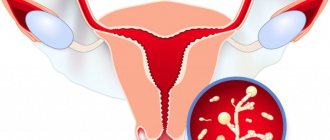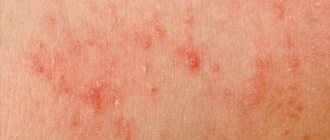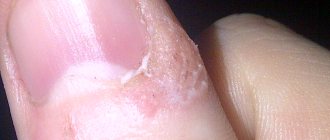Yesterday everything was fine, but today red dots appeared on the head of the penis?
Don't panic, it can be treated. Most importantly, do not try to deal with the problem yourself.
In such a situation, you need to determine as quickly as possible what caused them and prescribe treatment, because red dots are most likely a sign of inflammation. In most cases, the right treatment will help you get rid of red dots on your penis fairly quickly. It is important not to delay visiting a doctor.
Features of scrotal pigmentation
The scrotum is located between the anus and the penis, and is covered with sparse hair. The scrotum maintains a constant temperature of about 27 degrees to produce enzymes for normal sperm synthesis. The color of the skin of the scrotum changes throughout life. Normally, the shade is several tones darker than the base color of the skin. A change in the color of the genitals by several tones is not a cause for concern if there are no signs of an inflammatory process. This can occur under the influence of an increase in melanin levels, injuries, friction of the outer membranes of the organ against underwear, skin lesions with chemicals over a long period of time (this reaction can be caused by detergent residues). You should immediately consult a doctor if a dark spot appears on the scrotum and it expands, as well as if there are signs of an inflammatory process.
Dark spots without other symptoms
Normally, the penis, scrotum and perianal fold are slightly darker than the base skin tone. This shouldn't bother a man. But individual dark spots on the skin of the penis, as a rule, indicate mechanical damage, injury, scratching or squeezing of the organ with uncomfortable underwear, or too intense sexual contact. Darkening may be the result of burns or bruises. Bruises are accompanied by swelling. The shade of the dark spot may be red, dark green or purple. Mild injuries resolve on their own within a few days and do not require special treatment. If you have any alarming symptoms (atypical discharge, pain, itching and burning, peeling of the skin), you should consult a doctor as soon as possible to find out the cause and undergo appropriate treatment.
What do blue spots on the head of the penis mean?
In most cases, blue spots are of vascular origin.
They are clotted blood.
There are several possibilities why this could happen:
- injury to the penis - a normal bruise has appeared, which will go away on its own after some time
- bleeding without injury - may indicate problems with blood clotting or increased fragility of blood vessels
- vasculitis – inflammation of blood vessels
- thrombophlebitis - inflammation of a vein and the appearance of a blood clot inside it
Less commonly, the cause is a skin lesion or rash.
This may be a nevus and some dermatological diseases.
Increased melanin production
In this case, the rashes are usually significant, but do not pose a danger if the man does not experience discomfort or pain, and the spot itself does not change in appearance over time and does not increase in size. Painless changes in pigmentation are called Fordyce spots.
This pathology does not have a negative impact on human health, but causes a lot of other inconveniences, including aesthetic ones. Most often, this disease is diagnosed in adolescence, when sebum is actively produced under the influence of hormones. Lack of therapy will not affect the patient's condition in any way. However, rashes are a cosmetic problem that causes inconvenience and psychological discomfort.
Jojoba oil will help “whiten” dark spots on the shaft of the penis. After using this product, the sebaceous glands are externally reduced, and the severity of the spots is reduced. It is important that jojoba oil will not help with old rashes. Eight out of ten patients are characterized by relapses, that is, after some time, dark spots on the penis appear again. In this case, patients often use Retin-A cream and mummy-based ointments.
Light spots may appear if vitiligo develops. In this case, dark spots are normal areas of the skin, which against the background of the disease seem to be a pathology. This is an autoimmune disorder. The disease does not cause any inconvenience (except for an aesthetic problem), but after prolonged contact with ultraviolet rays, tissue burns develop. The pathology cannot be treated.
Spots on the penis with hemorrhagic vasculitis
Systemic vasculitis may be accompanied by spontaneous hemorrhages under the skin.
In this case, blue spots appear even without injury.
But they form not only on the penis, but throughout the body.
The disease is characterized by a hemorrhagic rash.
Initially, the elements are small and red.
But then they get larger and turn blue.
Over time, the elements fade and disappear.
Many patients simultaneously develop articular syndrome.
The gastrointestinal tract and other organs are often involved.
Human papillomavirus
About thirty of the many HPV viruses are localized in the genital area, anus and rectum. One of the most dangerous is HPV-18, which can cause precancerous diseases in men. A person can be a carrier of the virus, but not get sick. The disease manifests itself with age and with decreased immunity. Infection is usually accompanied by some social and medical factors: early onset of sexual activity, multiple sexual partners, bad habits, the presence of sexually transmitted diseases and inflammatory processes in the urinary tract.
HPV-18 provokes the appearance of dark spots on the penis and, in general, in the male genital area. This is a precancerous condition. Without treatment, the spots turn into malignant tumors. Numerous red or purple spots and plaques may appear that grow slowly and may thicken. Additionally, there are always symptoms of reduced immunity: prolonged course of any disease, frequent fungal and colds, gastric ulcers, tuberculosis.
Radiation dermatitis on the penis
Occurs after improperly administered radiation therapy.
Radiation is a treatment option not only for cancer, but also for acne and psoriatic plaques.
Radiation dermatitis can be triggered by even mild radiation with a minimal dose.
Hyperpigmented spots are one of the manifestations of the disease.
It is reversible.
Sometimes chronic dermatitis develops.
This is possible if the radiation dose exceeds 30 Gy.
After 3 weeks, the epidermis peels off.
Healing lasts 1-1.5 months.
In the last few years, atrophic changes in the skin have been increasing.
Foci of depigmentation and hyperpigmentation appear.
Fungal diseases
Dark spots on the penis, combined with the appearance of plaque, unpleasant odor, itching, flaking, burning and pain, may indicate the fungal nature of the appearance of pigmentation. Spots with a white coating on the head of the genital organ are a sign of infection by fungi of the genus Candida (thrush). Pigmentation is provoked by hormonal disorders due to prolonged use of antibacterial drugs, steroids or anabolic steroids, intestinal dysbiosis, epidermophytosis or rubrophytosis. With the last two diseases, dark spots on the penis are accompanied by pigmentation on the inner thighs, on the scrotum and in the perineum.
Reasons for appearance
Pigmented dark spots on the skin of the genital organ, shaft and foreskin are provoked by the individual characteristics of the patient.
There's nothing wrong with them. However, it is still worth seeing a doctor. Formations may be symptoms of the following pathological conditions:
- allergic reaction;
- fungal infection;
- human papillomavirus;
- candidiasis;
- melanopathy;
- oncology.
For the listed diseases, qualified medical intervention is needed. Come to the hospital for diagnostics. Self-medication is unacceptable.
Allergy and fungus
A spot on the skin can form when an allergen enters the body. This can be a response to barrier contraception (condoms), intimate hygiene products, poor-quality lubricants, etc. To prevent the occurrence of a pathological condition, you need to carefully select these items.
Clinical manifestations of an allergic reaction:
- peeling and itching sensations;
- dark spots;
- blisters, erosions, rashes;
- swelling and redness of the mucous membranes.
The fungus can enter the human body both from the external environment and live on the glans penis as a conditional pathogen. When the immune system is weakened, the microorganism provokes the development of various diseases of the genitourinary system.
Clinical picture:
- skin itching;
- red spots or tissue hyperemia;
- pain on palpation;
- burning and discomfort when passing urine;
- the appearance of a white coating with a specific “aroma”.
Whatever the cause of the fungus, self-treatment is not recommended. This will lead to aggravation of the pathological condition. Only a qualified doctor can prescribe effective therapy.
Human papillomavirus and candidiasis
HPV causes dark brown spots on the penis in the initial stages of its development.
Over time, they form genital warts or flat warts. The growths come in different tones: pinkish, beige, dark. HPV is transmitted through sexual contact (through unprotected sex of any kind) and through household contact (using other people's bath accessories, bedding and underwear, etc.). Genital condyloma and flat wart can develop into a malignant neoplasm. Candidiasis is a disease that affects women.
During unprotected sex, the fungus is transmitted to the man. Associated symptoms:
- white spots on the penis (in the initial stages of development);
- hyperemia;
- difficult and painful urination;
- burning sensation when palpating the organ;
- feeling of dryness and tightness of the skin;
- curdled white coating.
In the initial stages of occurrence, the cheesy coating is easily removed by washing. In its place only white spots remain.
Melanopathy
Melanopathy is a phenomenon in which there is a large accumulation of the coloring pigment melanin in the body.
This can happen due to physiological factors: the influence of ultraviolet radiation in people with dark skin. For pathological reasons: it appears where its level is usually normal (in the kidneys, brain, mucous membranes). Melanopathy can be inherited. And also occur as a result of endocrine diseases:
- pathological conditions of the adrenal glands;
- changes in the synthesis of melanophore hormone by the pituitary gland;
- changes in the functioning of the reproductive glands;
- lack of nutrients: pellagra, scurvy.
Symptomatic manifestations of the lesion:
- black spots;
- severe skin sensitivity to ultraviolet radiation;
- grouping of focal pigmentation into large zones;
- dermatic swelling, thickening of the stratum corneum, atrophy of the dermis;
- itching and irritation of damaged areas;
- disturbances in the functioning of the nervous system and endocrine glands.
If these symptoms occur, you should contact a therapist, urologist or endocrinologist.
Oncology
With cancer, dark spots form on the penis. They have an almost black tint. The formations are similar to melanoma and have clear boundaries.
If the spots begin to grow sharply in size, change shape and rapidly spread across the skin, then this may be a sign of a malignant tumor. Self-medication in this case is strictly prohibited. The diagnosis is carried out by an oncologist using the necessary equipment.
Men over 50 years of age who have a hereditary predisposition to cancer are at risk of developing cancer. Patients with severe itching and bleeding also need to take the resulting black spots seriously.
Allergic reaction
The reaction occurs as a result of an allergen entering the body. Barrier contraceptives, intimate lubricants, hygiene products, or laundry detergent can cause dark spots to appear on the glans penis. Itching most often appears with balanoposthitis, but can also be characteristic of some other diseases of an allergic nature.
Methods of treatment and prevention
To get rid of spots on the penis, you need to cure the disease that caused them. Therefore, if they occur, you need to contact a specialist to determine the type of illness. For certain pathologies, the following groups of medications are prescribed:
- antibiotics;
- medications to prevent fungal synthesis;
- antiviral drugs;
- antihistamines;
- creams and ointments for external application (eliminate pain, remove peeling, burning and itching).
When conservative therapy does not bring the desired result, resurfacing of the affected area with a laser beam is prescribed. This procedure eliminates aesthetic errors. After laser therapy, oral intake of vitamin A is recommended. The duration of the course is determined by a specialist.
Moles are eliminated using surgery, laser removal, electrocoagulation, cryodestruction. Manipulation is performed only when necessary. If moles cause severe discomfort, they are susceptible to injury.
Prevention of spots on the genitals cannot 100% protect a person from their occurrence, but will significantly reduce the risk of their formation.
The following recommendations must be followed:
- compliance with personal hygiene rules, careful selection of detergents, comfortable underwear made from natural fabrics;
- giving up bad habits (alcohol, nicotine);
- consumption of vitamins, minerals;
- daily moderate physical activity;
- maintaining water balance;
- careful selection of condoms and lubricant;
- caring for the epidermis of the genital organ (using special creams with vitamins A, B);
- balanced diet containing nutrients;
- timely treatment of concomitant pathological conditions;
- Always use barrier contraception during sexual intercourse;
- avoid promiscuous relationships.
Regularly, twice a year, it is recommended to undergo a routine diagnostic examination by highly qualified specialists. This will help identify diseases in the early stages of development. In the initial stages, the pathological process is more amenable to therapeutic measures.
Oncological diseases
Are there dark spots on your penis? This is a reason to go to the clinic for a medical examination, because such a symptom may indicate the development of cancer. The spots have a black or very dark tint and have clear outlines.
If serious pathologies are suspected, the doctor will refer the patient for an ultrasound of the testicles and scrotum. It is imperative to undergo an extraordinary examination if the spots are rapidly growing or changing their shape. It is better to contact your oncologist directly.
Particular attention should be paid to the symptoms of cancer in men over fifty years of age who are predisposed to cancer. It is important to monitor the condition of patients who have itching and bleeding.
Blue spot due to a bruise on the penis
If a person gets a bruise on their penis and doesn't go to the doctor, it's just a bruise and nothing more.
But if he went to see a urologist, this is already a bruise of the external genitalia.
This is exactly the kind of entry a person will receive in their medical record.
The main causes are sports, falls on a hard object, or domestic fights.
Large hematomas are quite dangerous and always require a full examination.
Because a large bruise may hide a rupture of the tunica albuginea of the corpora cavernosa, damage to the corpus spongiosum or the urethra.
The most severe injuries occur during an erection.
If it is applied when the penis is not erect, it is usually limited to only a subcutaneous hematoma.
Necrosis of penile tissue
Necrosis leads to tissue death of the reproductive system organ, followed by amputation. The disease progresses very quickly. For this reason, if a black spot appears on the penis, you should immediately visit a doctor. Necrotic changes occur due to disruptions in the circulatory system or inflammatory processes complicated by infection.
Ignoring the problem will quickly lead to disastrous consequences: dead tissues are subjected to rotting, the infection is located in nearby areas, general intoxication of the body and septic conditions occur. In some cases, vital organs begin to fail.
Tests for a blue spot on the penis
Patients often come to the pharmacy and ask what to apply on a blue spot to make it disappear.
It is likely that in such a situation the pharmacist will indeed offer you some kind of ointment.
After all, it is important for him to sell the goods and make money for the pharmacy.
But the probability of guessing with the drug is not too high.
We have already found out that there can be quite a few reasons for the appearance of a blue spot or several spots on the penis.
They are all completely different in origin.
In addition, stains often cannot be removed using conservative methods.
But they can be eliminated using laser or other minimally invasive methods.
Some causes of blue spots are dangerous and threaten your health.
For example, they may indicate impaired blood clotting or incipient cancer.
Therefore, if you are not sure, then it is a bruise, it is better to consult a doctor and get examined.
It is also worth going to the doctor if the bruise is large and painful.
Because serious damage to the penis is possible.
If left untreated, in the long term after injury, severe complications occur, such as scarring of the urethra or deformation of the penis.
Erectile dysfunction, infectious complications, etc. may develop.
In such a situation, you need to consult a urologist or dermatovenerologist.
It will conduct an examination and dermatoscopy.
Examine the spot under a Wood's lamp.
Then he will take the necessary tests.
After injury, examination can be performed using ultrasound.
It is important to assess the extent of damage to the penis.
If suspicious spots with clear boundaries that are not bruises appear on the skin, their origin can be assumed using dermatoscopy.
This is an examination of the skin under magnification.
Tests are often required to verify the diagnosis.
A scraping and examination of the cytological picture is carried out.
If the doctor suspects that it may be malignant, it must be removed.
Then the removed node is sent for histological examination.
A conclusion comes from the laboratory that allows you to accurately determine what it is: nevus, hemangioma, melanoma or other formation.
If the process turns out to be malignant, this will affect further treatment.
A repeat operation may be performed with wider removal of the skin in the area where the pathological focus is located.
Systemic diseases can also cause blue spots to appear.
It is likely that bleeding under the skin of the penis is due to decreased blood clotting.
It can be caused by a number of diseases.
Therefore, a coagulogram is performed.
During this test, the doctor checks how quickly the blood clots.
A complete blood test allows you to understand whether there are enough platelets in the blood.
If necessary, a study is carried out to determine the content of various blood clotting factors.
Once the cause of the blue spots has been determined, the doctor will prescribe treatment.
Symptoms of pathology
A dark spot on the head of the penis or the shaft of the genital organ, as well as on the scrotum, inner thigh or perineum is often a sign of the development of a serious disease. You should contact a dermatovenerologist or urologist as soon as possible if the following symptoms are present:
- itching, burning, pain in a calm state, during erection or urination;
- swelling, skin tone changes, spots grow, their boundaries change;
- atypical discharge, its color, consistency or smell changes.
Examination and tests
If a patient complains of dark spots on the penis, the doctor first conducts an examination and then issues referrals for tests for STDs, fungus, blood tests for syphilis, checking hormonal status, scrapings (usually taken if psoriasis is suspected). If the urologist suspects oncology, the patient is referred for an ultrasound. Further tactics for patient management depend on the reasons that caused the appearance of spots on the genitals.
Treatment tactics
Dark spots on the penis can be a sign of many diseases. Treatment depends on the specific diagnosis. In case of injuries, surgical intervention may be indicated; in case of bruises, the diseased organ must be provided with rest; STIs and syphilis are treated with antibacterial drugs; mycoses are treated with antifungal drugs orally or by injection; additionally, ointments are prescribed for topical use. Vitiligo currently has no cure. For genital herpes, the use of Acyclovir, local antiherpetic and anti-inflammatory drugs is indicated. If the patient is diagnosed with eczema or psoriasis, then corticosteroids are prescribed, and for balanoposthitis, antibacterial drugs for topical use are indicated.
In children
A spot on a child’s testicle indicates an allergy and fungal infection. In infants, the disease develops due to allergies.
What pathologies do white spots on the testicles indicate:
- HPV;
- problems with the thyroid gland and hormones;
- lipoma;
- wart;
- cyst.
White pigmentation is most often accompanied by itching and discomfort when walking or going to the toilet.
In cases of a wen or cyst, the formations gradually increase in size, begin to protrude above the skin and cause severe discomfort to the man. In such cases, urgent medical intervention is required.











